Very tasty and simple sauerkraut according to my grandmother’s recipe, which was used in the old days
For centuries, our ancestors prepared sauerkraut for the winter according to recipes that were passed down from generation to generation. This preparation solved the problem of vitamin deficiency and decorated the table on holidays and weekdays. Tasty, aromatic, juicy, crispy - this is exactly what cabbage looks like, made according to grandma’s classic recipe. In order for the dish to turn out correctly, you need to follow the technology and know the secrets of cooking.
We’ll tell you in this article how delicious cabbage is fermented according to grandma’s recipe.
Selection and preparation of cabbage for sourdough
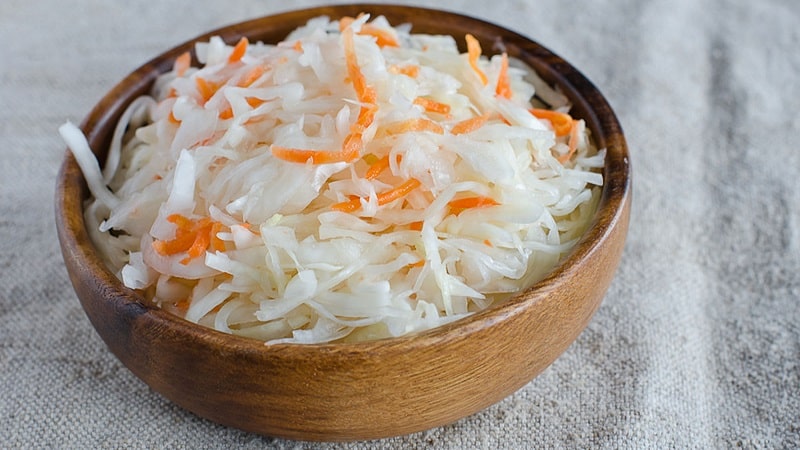
Pickling begins with choosing a variety. It must be late cabbage. Early and mid-ripening vegetables become soft after cooking and are not crunchy at all.
The most popular varieties for pickling:
- Glory;
- Present;
- Moscow late;
- Stone head.
If vegetables are grown on your own plot, there are no problems with variety and quality. But when buying heads of cabbage at the market or in a supermarket, you should pay attention to the following details:
- take not dark green, but white heads of cabbage;
- heads of cabbage need dense ones - when they seem small, but heavy;
- the medium size is more convenient - it’s easier to cut out the stalk and use it in a shredder (very large ones will have to be cut into several parts);
Ferment vegetables immediately, without waiting for them to wilt. Before fermentation, the heads of cabbage are cleared of the top leaves so that they remain clean. They cannot be washed. Then the forks are cut and the stalk is removed.
Tara
The container is prepared in advance. If it is a wooden barrel, then it is poured with boiling water twice, steamed for 20 minutes, filled with water and left for 2-3 days. The wood needs to be soaked so that the brine does not leak out of the barrel later.
If plastic food barrels or enamel buckets are used for fermentation, everything is much simpler. They are washed with soda, rinsed and wiped dry. Do the same with stainless steel.
Attention! Sauerkraut cannot be fermented in aluminum or enamel containers if they are chipped. This will not only spoil the taste, but also harm your health.
Many modern housewives ferment in three-liter jars. This is convenient for small volumes of workpieces. But our grandmothers put cabbage in wooden tubs of 20 liters or more. It is in large containers that it acquires an extraordinary taste and juiciness.
In oak barrels, wood takes part in fermentation and imparts a special taste and aroma. However, the amount of brine also affects the taste. Cabbage produces juice under its own weight. Fermentation is more intense, more enzymes are released.
An ancient way to pickle cabbage
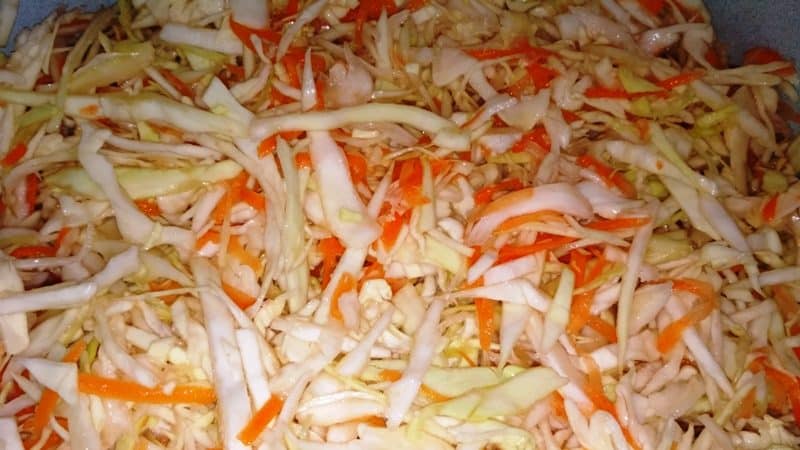
The consistency in grandma's recipe should not be broken. Any little thing can ruin the product.
The classic version of the ratio of products for grandma’s recipe for 10 kg of cabbage:
All proportions are relative: vegetables come in different varieties, everyone has different tastes. It is not necessary to put apples.
Cooking process:
- The heads of cabbage are chopped and placed in a basin along with carrots grated on a coarse grater. Add salt.
- The vegetables are crushed and ground until the juice is released. It's better to do it by hand.
- Place the grated vegetables into a fermentation container.First line the bottom with clean, whole leaves.
- Tamp and lightly press so that the released juice covers the cabbage.
- Sprinkle cumin and cranberries on top and place apples, having previously cut out the core.
- Chop the next portion, combine with carrots, grind, compact, squeeze, sprinkle with caraway seeds and cranberries. And so on until the heads of cabbage run out.
- The last layer is crushed, making sure that the juice covers the vegetables by 2 cm.
- Line the surface with gauze or loose cotton cloth.
- They put pressure on it, which is first scalded and wiped dry.
- After 2-3 days they begin to pierce the vegetable mass. This is necessary to allow the gases produced during fermentation to escape. If you don't do this, the cabbage will taste bitter.
- When the brine becomes clear and the cabbage tastes sour and salty, the barrel is put in a cold place. If it is not possible to store it in this form, transfer it to jars, seal it tightly and keep it in the refrigerator.
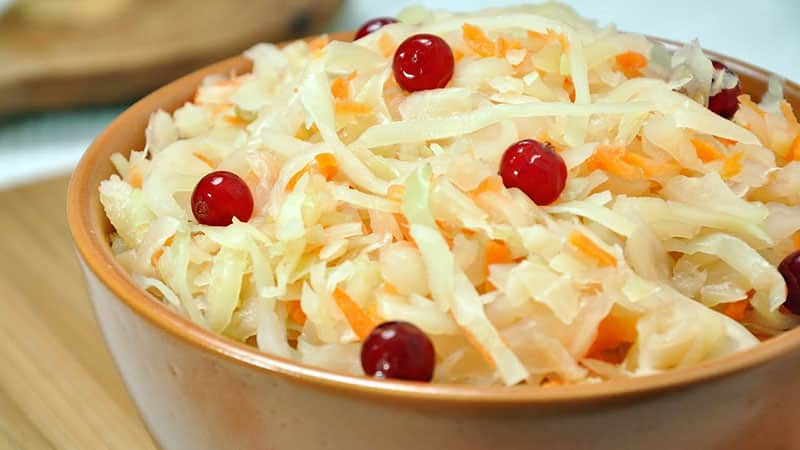
Recipe Variations
Grandma's classic preparation recipe placed in large containers. Modern housewives often use three-liter jars for this and use various cooking options.
In its own juice
How to taste salt in your own juice? To prepare, take 3.5 kg of cabbage, 1 medium carrot, 1 tbsp. l. coarse rock salt, 1 tsp. Sahara.
Important! Iodized and fine salt are not suitable for pickling.
How to cook:
- The heads of cabbage are chopped and the carrots are grated on a coarse grater.
- Add mixed salt and sugar.
- Grind until juice appears.
- Leave the vegetables for 20 minutes to release even more juice.
- Place in the jar a little at a time, compacting tightly.
- The laying stops 2-3 cm before the edge of the neck.
- Cover with gauze.Place the container on a plate so that the juice does not leak onto the table during fermentation.
- Leave it for three days, piercing the vegetable mass through and through several times every day to release the gas.
- Place in the refrigerator, covering with a nylon lid.
The juice should cover the cabbage throughout the cooking period. To do this, it is periodically kneaded. Instead of bending, you can put two bamboo sticks crosswise inside the jar. They will keep the cabbage level and prevent the juice from sinking.
In brine
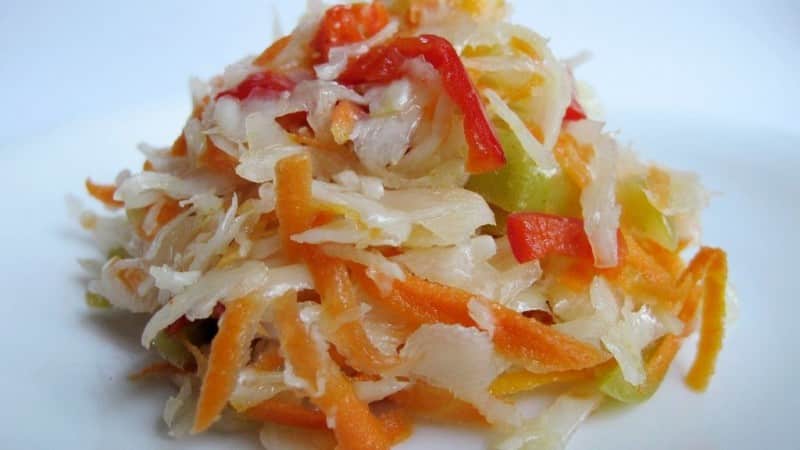
This cabbage is prepared simply and quickly. To do this you will need a 2-2.3 kg head of cabbage, 1 large carrot, bay leaf, peppercorns. For brine: 1.5 liters of water, 2 tbsp. l. salt and sugar.
Preparation:
- Prepare the brine by dissolving salt and sugar in boiling water.
- The heads of cabbage are chopped and the carrots are grated on a coarse grater.
- Mix the vegetables without grinding.
- Place in a three-liter jar, lightly tamping.
- Between the layers - bay leaf, pepper.
- Pour in cooled brine.
- Cover with gauze and place on a plate.
- Keep for 2-3 days. Periodically pierce and crush.
- When the cabbage acquires a characteristic taste, it is put in the refrigerator.
How and with what to serve this cabbage
In the autumn-winter period, sauerkraut is indispensable. It is consumed as a salad and as part of other dishes - first and second.
The most vitamin-packed option is cabbage with onions, seasoned with sunflower oil and sprinkled with herbs. This is exactly what our grandmothers served on the table. It goes well with any meat, mashed potatoes, and lovers of a healthy lifestyle will happily eat it for dinner.
It’s hard to imagine vinaigrette, sour cabbage soup and borscht without cabbage. Stewed sauerkraut with meat is a hearty and healthy dish. Cabbage is stewed with mushrooms, sausages and even fish.
Terms and conditions of storage
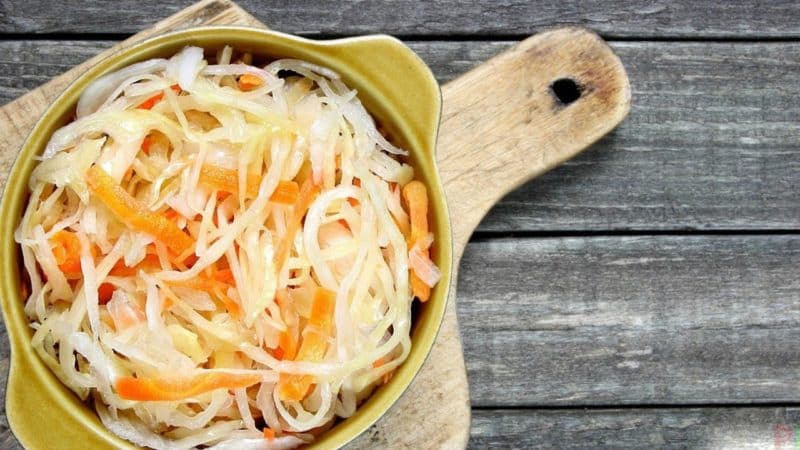
If the cabbage is in a barrel and covered with juice, and the room temperature is about 0°C, it will be preserved and will not lose quality for about 8-9 months.
Cabbage fermented in a glass jar does not last long at room temperature. This preparation will not spoil for 2-3 weeks. If you pour vegetable oil on top, it will last a week longer. At above-zero temperatures, the product is edible for 5 days. Most often, the product is transferred to smaller jars and stored in the refrigerator.
The best storage conditions are 0°C and a glazed loggia. Only as much product is taken from the container as is needed for one time; the cabbage is not returned to the container.
Advice from experienced housewives
Even an experienced housewife turns out cabbage differently every year. To get a delicious pickled product the first time, use the following recommendations:
- Choose your variety carefully. If you buy early or mid-season cabbage, you will get soft cabbage without crunch.
- Choose medium and large heads of cabbage - there will be less waste.
- The beauty of the dish depends on the amount of carrots: the more, the brighter.
- If you add sugar, only a little bit, otherwise the workpiece will be slippery.
- Make sure that the juice covers the cabbage and pierce it as often as possible - this guarantees the absence of bitterness.
- Leave the product to ferment on the waxing moon.
Conclusion
Sauerkraut is the main winter supplier of vitamins and microelements. Full fermentation and pickling of cabbage occurs when large containers and a lot of vegetables are used for preparation. This product is stored longer and does not lose its taste and beneficial qualities all winter.